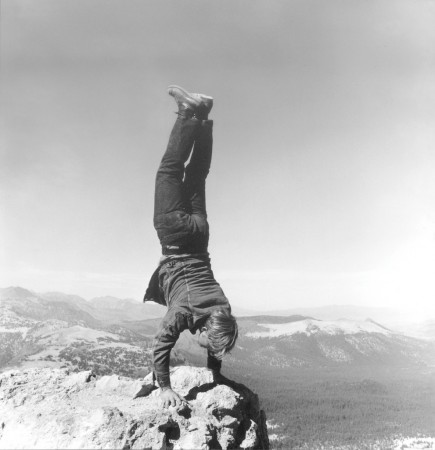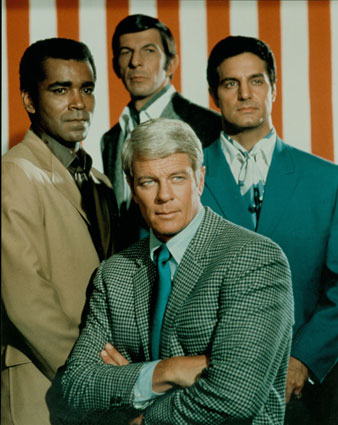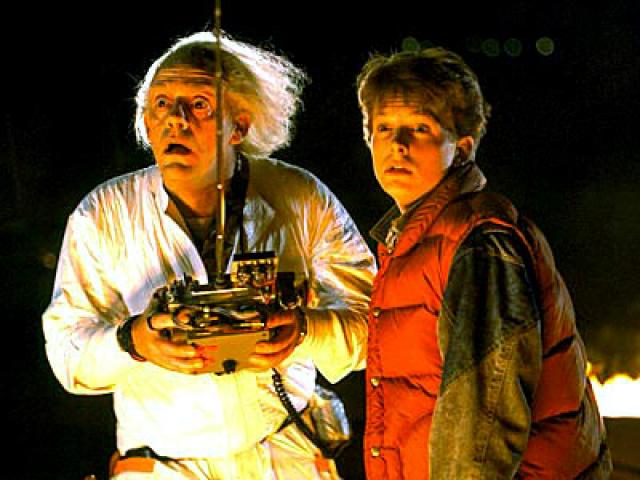Archive for the ‘Imagination’ Category
Mindset for Doing New
 The more work I do with innovation, the more I believe mindset is the most important thing. Here’s what I believe:
The more work I do with innovation, the more I believe mindset is the most important thing. Here’s what I believe:
Doing new doesn’t take a lot of time; it’s getting your mind ready that takes time.
Engineers must get over their fear of doing new.
Without a problem there can be no newness.
Problem definition is the most important part of problem solving.
If you believe it can work or it can’t, you’re right.
Activity is different from progress.
Thinking is progress.
In short, I believe state-of-the-art is limited by state-of-mind.
The Dark Art of Uncertainty
 Engineers hate uncertainty. (More precisely, it scares us to death.) And our role in the company is to snuff it out at every turn, or so we think.
Engineers hate uncertainty. (More precisely, it scares us to death.) And our role in the company is to snuff it out at every turn, or so we think.
To shield ourselves from uncertainty, we take refuge in our analyses. We create intricate computer wizardry to calm our soles. We tell ourselves our analytic powers can stand toe-to-toe with uncertainty. Though too afraid to admit, at the deepest level we know the magic of our analytics can’t dispatch uncertainty. Like He-Who-Should-Not-Should-Be-Named, uncertainty is ever-present and all-powerful. And he last thing we want is to call it by name.
Our best feint is to kill uncertainty before it festers. As soon as uncertainty is birthed, we try slay it with our guttural chant “It won’t work, it won’t work, it won’t work”. Like Dementors, we drain peace, hope, and happiness out of the air around a new idea. We suck out every good feeling and reduce it to something like itself, but soulless. We feed on it until we’re left with nothing but the worst of the idea.1
Insidiously, we conjure premonitions of mythical problems and predict off-axis maladies. And then we cast hexes on innovators when they don’t have answers to our irrelevant quandaries.
But our unnatural bias against uncertainty is misplaced. Without uncertainty there is no learning. Luckily, there are contrivances to battle the dark art of uncertainty.
When the engineering warlocks start their magic, ask them to be specific about their premonitions. Demand they define the problem narrowly – between two elements of the best embodiment; demand they describe the physical mechanisms behind the problem (warlocks are no match for physics); demand they define the problem narrowly in time – when the system spools up, when it slows down, just before it gets hot, right after it cools down. What the warlocks quickly learn is the problem is not the uncertainty around the new idea; the problem is the uncertainty of their knowledge. After several clashes with the talisman of physics, they take off their funny pointy hats, put away their wands, and start contributing in a constructive way. They’re now in the right frame of mind to obsolete their best work
Uncertainty is not bad. Denying it exists is bad, and pretending we can eliminate it is bad. It’s time to demonstrate Potter-like behavior and name what others dare not name.
Uncertainty, Uncertainty, Uncertainty.
Less With Far Less
 We don’t know the question, but the answer is innovation. And with innovation it’s more, more, more. Whether it’s more with less, or a lot more with a little more, it’s always more. It’s bigger, faster, stronger, or bust. It’s an enhancement of what is, or an extrapolation of what we have. Or it’s the best of product one added to product two. But it’s always more.
We don’t know the question, but the answer is innovation. And with innovation it’s more, more, more. Whether it’s more with less, or a lot more with a little more, it’s always more. It’s bigger, faster, stronger, or bust. It’s an enhancement of what is, or an extrapolation of what we have. Or it’s the best of product one added to product two. But it’s always more.
More-on-more makes radical shifts hard because with more-on-more we hold onto all functionality then add features, or we retain all features then multiply output. This makes it hard to let go of constraints, both the fundamental ones – which we don’t even see as constraints because they masquerade as design rules – and the little-known second class constraints – which we can see, but don’t recognize their power to block first class improvements. (Second class constraints are baggage that come with tangential features which stop us from jumping onto new S-curves for the first class stuff.)
To break the unhealthy cycle of more-on-more addition, think subtraction. Take out features and function. Distill to the essence. Decree guilty until proven innocent, and make your marketers justify the addition of every feature and function. Starting from ground zero, ask your marketers, “If the product does just one thing, what should it do?” Write it down as input to the next step.
Next, instead of more-on-more multiplication, think division. Divide by ten the minimum output of your smallest product. (The intent it to rip your engineers and marketers out of the rut that is your core product line.) With this fractional output, ask what other technologies can enable the functionality? Look down. Look to little technologies, technologies that you could have never considered at full output. Congratulations. You’ve started on your migration toward with less-with-far-less.
On the surface, less-with-far-less doesn’t seem like a big deal. And at first, folks roll their eyes at the idea of taking out features and de-rating output by ten. But its magic is real. When product performance is clipped, constraints fall by the wayside. And when the product must do far less and constraints are dismissed, engineers are pushed away from known technologies toward the unfamiliar and unreasonable. These unfamiliar technologies are unreasonably small and enable functionality with far less real estate and far less inefficiency. The result is radically reduced cost, size, and weight.
Less-with-far-less enables cost reductions so radical, new markets become viable; it makes possible size and weight reductions so radical, new levels of portability open unimaginable markets; it facilitates power reductions so radical, new solar technologies become viable.
The half-life of constraints is long, and the magic from less-with-far-less builds slowly. Before they can let go of what was, engineers must marinate in the notion of less. But when the first connections are made, a cascade of ideas follow and things spin wonderfully out of control. It becomes a frenzy of ideas so exciting, the problem becomes cooling their jets without dampening their spirit.
Less-with-far-less is not dumbed-down work – engineers are pushed to solve new problems with new technologies. Thermal problems are more severe, dimensional variation must be better controlled, and failure modes are new. In fact, less-with-far-less creates steeper learning curves and demands higher-end technologies and even adolescent technologies.
Our thinking, in the form of constraints, limits our thinking. Less-with-far-less creates the scarcity that forces us to abandon our constraints. Less-with-far-less declares our existing technologies unviable and demands new thinking. And I think that’s just what we need.
Creativity’s Mission Impossible
 Whether it’s a top-down initiative or a bottom-up revolution, your choice will make or break it.
Whether it’s a top-down initiative or a bottom-up revolution, your choice will make or break it.
When you have the inspiration for a bottom-up revolution, you must be brave enough to engage your curiosity without self-dismissing. You’ll feel the automatic urge to self-reject – that will never work, too crazy, too silly, too loony – but you must resist. (Automatic self-rejection is the embodiment of your fear of failure.) At all costs you must preserve the possibility you’ll try the loony idea; you must preserve the opportunity to learn from failure; you must suspend judgment.
Now it’s time to tell someone your new thinking. Summon the next level of courage, and choose wisely. Choose someone knowledgeable and who will be comfortable when you slather them with the ambiguity. (No ambiguity, no new thinking.) But most importantly, choose someone who will suspend judgment.
You now have critical mass – you, your partner in crime, and your bias for action. Together you must prevent the new thinking from dying on the vine. Tell no one else, and try it. Try it at a small scale, try it in your garage. Fail-learn-fail until you have something with legs. Don’t ask. Suspend judgment, and do.
And what of top down initiatives? They start with bottom-up new thinking, so the message is the same: suspend judgment, engage your bias for action, and try it. This is the precursor to the thousand independent choices that self-coordinate into a top-down initiative.
New thinking is a choice, and turning it into action is another. But this is your mission, if you choose to accept it.
I will be holding a half-day Workshop on Systematic DFMA Deployment on June 13 in RI. (See bottom of linked page.) I look forward to meeting you in person.
When It’s Time For a New Cowpath
 Doing new things doesn’t take a long time. What takes a long time is seeing things as they are. Getting ready takes time, not doing new. Awareness of assumptions, your assumptions, others’ assumptions, the company’s – that’s critical path.
Doing new things doesn’t take a long time. What takes a long time is seeing things as they are. Getting ready takes time, not doing new. Awareness of assumptions, your assumptions, others’ assumptions, the company’s – that’s critical path.
An existing design, product, service, or process looks as it does because of assumptions made during long ago for reasons no longer relevant (if they ever were). Design elements blindly carried forward, design approaches deemed gospel, scripted service policies that no longer make sense, awkward process steps proceduralized and rev controlled – all artifacts of old, unchallenged assumptions. And as they grow roots, assumptions blossom into constraints. Fertile design space blocked, new technologies squelched, new approaches laughed out of town – all in the name of constraints founded on wilted assumptions. And the most successful assumptions have the deepest roots and create the deepest grooves of behavior.
Cows do the same thing every day. They wake up at the same time (regardless of daylight savings), get milked at the same time, and walk the same path. They walk in such a repeatable way, they make cowpaths – neat grooves walked into the landscape – curiously curved paths with pre-made decisions. No cow worth her salt walks outside the cowpath. No need. Cows like to save their energy for making milk at the expense of making decisions. If it was the right path yesterday, it’s right today.
But how to tell when old assumptions limit more than they guide? How to tell when it’s time to step out of the groove? How to tell a perfectly good cowpath from one that leads to a dry watering hole? When is it time to step back and create new history? Long ago the first cow had to make a choice, and she did. She could have gone any which way, and she did. She made the path we follow today.
With blind acceptance of assumptions, we wither into bankruptcy, and with constant second-guessing we stall progress. We must strike a balance. We must hold healthy respect for what has worked and healthy disrespect for the status-quo. We must use forked-tongue thinking to pull from both ends. In a yin-yang way, we must acknowledge how we got here, and push for new thinking to create the future.
Manage For The Middle
 Year-end numbers, quarter-to-quarter earnings, monthly production, week-to-week payroll. With today’s hyper-competition, today’s focus is today. Close-in focus is needed, it drives good stuff – vital few, productivity, quality, speed, and stock price. Without question, the close-in lens has value.
Year-end numbers, quarter-to-quarter earnings, monthly production, week-to-week payroll. With today’s hyper-competition, today’s focus is today. Close-in focus is needed, it drives good stuff – vital few, productivity, quality, speed, and stock price. Without question, the close-in lens has value.
But there’s a downside to this lens. Like a microscope, with one eye closed and the other looking through the optics, the fine detail is clear, but the field of view is small. Sure the object can be seen, but that’s all that can be seen – a small circle of light with darkness all around. It’s great if you want to see the wings of a fly, but not so good if you want to see how the fly got there.
Millennia, centuries, grand children, children. With today’s hyper-competition, today’s focus is today. Long-range focus is needed, it drives good stuff – infrastructure, building blocks, strategic advantage. Though it’s an underused lens, without question, the far-out lens has value.
But there’s a downside to this lens. Like a telescope, with one eye closed and the other looking through the optics, the field of view is enormous, but the detail is not there. Sure the far off target can be seen, but no details – a small circle of light without resolution. It’s great if you want to see a distant landscape, but not so good if you want to know what the trees look like.
What we need is a special set of binoculars. In the left is a microscope to see close-in – the details – and zoom out for a wider view – the landscape. In the right is a telescope to see far-out – the landscape – and zoom in for a tighter view – the details.
Unfortunately the physics of business don’t allow overlap between the lenses. The microscope cannot zoom out enough and the telescope cannot zoom in enough. There’s always a gap, the middle is always out of focus, unclear. Sure, we estimate, triangulate, and speculate (some even fabricate), but the middle is fuzzy at best.
It’s easy to manage for the short-term or long-term. But the real challenge is to manage for the middle. Fuzzy, uncertain, scary – it takes judgment and guts to manage for the middle. And that’s just where the best like to earn their keep.
The Supreme Court of Technology
 The Founding Fathers got it right with three branches: legislative to make laws; judicial to interpret laws; and executive to enforce them. Back then it was all about laws, and the system worked.
The Founding Fathers got it right with three branches: legislative to make laws; judicial to interpret laws; and executive to enforce them. Back then it was all about laws, and the system worked.
What the Founding Fathers could not realize was there was a powerful, pre-chrysalis force more powerful than laws, whose metamorphosis would exploit a gap in the three branch system. Technology has become a force more powerful than laws, and needs its own branch of government. We need a Supreme Court of Technology. (Think Ph.D. instead of J.D.)
Technology is the underpinning of a sustainable economy, an economy where citizens are well-educated, healthy, and happy, and where infrastructure is safe and supports the citizens’ needs. For countries that have it, technology generates the wealth to pay for education, healthcare, and bridges. Back then it was laws; today it’s technology.
The Founding Fathers knew interpretation of laws demanded consistency, consistency that transcended the election cycle, and, with its lifetime appointment, the Supreme Court was the mechanism. And it’s the same with technology: technology demands consistency of direction and consistency of purpose, and for that reason I propose a Supreme Court of Technology.
The Chief Justice of Technology and her Associate Justices set the long term technology policy for the country. They can be derided for its long time horizon, but they cannot be ousted for making the right decisions or their consistency of purpose. The Justices decide how to best spend their annual budget, which is substantial and adjusts with inflation and population. Since they are appointed for life, the Justices tell Congress how it goes with technology (and to stop with all this gridlock gamesmanship) and ask the President for her plan to implement the country’s technology policy. (Technology transcends political parties and election cycles.)
With the Supreme Court of Technology appointed and their first technology plan in place (think environment and energy), the country is on track to generate wealth sufficient to build the best educational system in the world (think creativity, art, science, math, and problem solving) to fuel the next generation of technology leadership.
Marinate yourself in scarcity to create new thinking
 There’s agreement: new thinking is needed for innovation. And for those that have tried, there’s agreement that it’s hard. It’s hard to create new thinking, to let go of what is, to see the same old things as new, to see resources where others see nothing. But there are some tricks to force new thinking, to help squeeze it out of ourselves.
There’s agreement: new thinking is needed for innovation. And for those that have tried, there’s agreement that it’s hard. It’s hard to create new thinking, to let go of what is, to see the same old things as new, to see resources where others see nothing. But there are some tricks to force new thinking, to help squeeze it out of ourselves.
The answer, in a word, is scarcity.
In the developing world there is scarcity of everything: food, shelter, electricity, tools, education; in the developed world we must fabricate it. We must dust off the long-neglected thought experiment, and sit ourselves in self-made scarcity.
Try a thought experiment that creates scarcity in time. Get the band together and ask them this question: If you had only two weeks to develop the next generation product, what would you do? When they say the question is ridiculous, agree with them. Tell them that’s the point. When they try to distract and derail, hold them to it. Don’t let them off the hook. Scarcity in time will force them to look at everything as a resource, even the user and the environment itself (sunlight, air, wind, gravity, time), or even trash or byproduct from something in the vicinity. At first pass, these misused resources may seem limited, but with deeper inspection, they may turn out to be better than the ones used today. The band will surprise themselves with what they come up with.
Next, try a thought experiment that creates scarcity of goodness. Get the band back together, and take away the major performance attribute of your product (the very reason customers buy); decree the new product must perform poorly. If fast is better, the new one must be slow; if stiff is better, the new one must be floppy; if big, think small. This forces the band to see strength as weakness, forces them to identify and release implicit constraints that have never been named. Once the bizarro-world product takes shape, the group will have a wonderful set of new ideas. (The new product won’t perform poorly, it will have novel functionality based on the twisted reality of the thought experiment.)
Innovation requires new thinking, and new thinking is easier when there’s scarcity – no constraints, no benchmarks, no core to preserve and protect. But without real scarcity, it’s difficult to think that way. Use the time-tested thought experiment to marinate yourself in scarcity, and see what comes of it.
Imagine your next innovation
- The economy has picked up, but your sales have dropped off.
- Competitors’ products work better than yours.
- Competitors’ product launches are more frequent than yours.
- The number of competitors is increasing.
- The sales team is angry – they cannot sell against competitors.
- The product roadmap is more of the same.
The situation is clear – you’re behind your competitors, and they are accelerating. The action plan is clear – leapfrog your competitors.
Declare failure with the more-of-the-same product roadmap, and imagine a new one. The new one must leapfrog your competitors (though they’re accelerating). Imagine a new product roadmap that’s so radical it’s borderline ridiculous, that’s so outrageous you’re afraid to present it. (A sign it’s right on-the-mark.) Imagine one you have little to no idea how to do. Now, take the best of the ridiculous product roadmap and replace the oldest parts of the old one. Create a nice hybrid, and make it happen.
Situation A is tough because there is stress around the company’s future, and it’s easy because there’s a clear reason to innovate – company survival.
a
Situation B
- The economy has dropped off, but your sales have picked up.
- Your products work better than your competitors’.
- Your product launches are more frequent than your competitors’.
- There the number of competitors is decreasing.
- The sales team is happy – they can sell against competitors.
- The product roadmap is more of the same.
The situation is clear – you’re ahead of your competitors, and they are accelerating. The action plan is clear – leapfrog yourself.
Declare failure with the more-of-the-same product roadmap, and imagine a new one. The new one must leapfrog yourself (though you’re accelerating). Imagine a new product roadmap that’s so radical it’s borderline ridiculous, that’s so outrageous you’re afraid to present it. (A sign it’s right on-the-mark.) Imagine one you have little to no idea how to do. Now, take the best of the ridiculous product roadmap and replace the oldest parts of the old one. Create a nice hybrid, and make it happen.
Situation B is easy because there is no stress around the company’s future, and it’s difficult because there is no clear reason to innovate.
There’s no reason to argue which situation you’re in, no need to argue which is more difficult. Either way, leapfrog something.
WHY, WHAT, HOW to Improve Engineering
 When asked how to improve manufacturing, the recipe is clear: lean. When asked how to improve engineering, the recipe: there isn’t one. Each engineering improvement effort is unique; though there are common themes and building blocks, each has its own fingerprint.
When asked how to improve manufacturing, the recipe is clear: lean. When asked how to improve engineering, the recipe: there isn’t one. Each engineering improvement effort is unique; though there are common themes and building blocks, each has its own fingerprint.
Each company has its own strengths, weaknesses, opportunities and threats; each company has unique products and markets; each its own goals; each its own culture; each its own future state. Informed by uniqueness, the recipe is unique. To create your unique improvement recipe, I suggest WHY, WHAT, HOW.
WHY
Before your engineering improvement recipe can be formed, the fundamental shaping question must be answered. Take a breath, fire up your laptop, put on your headphones, and queue up your best music. Type this question:
WHY does our business demand we improve engineering?
Now, type the answer. (Literally.) Use nouns and verbs to explain why engineering must improve. If you can’t, stop. Without a clear, concise, jargon-free answer nothing can be done to advance the cause. (Though there can be plenty of activity, there can be no progress.) Without the WHY, you cannot pass GO. You must create a clear, concise WHY.
Seek out help from trustworthy people to create the WHY. Don’t move forward until you understand it well enough to explain it to the engineering organization. Now, with WHY in place, it’s time for WHAT.
WHAT
Informed by WHY, it’s time for WHAT. Secure a quiet spot, scare up a big piece of paper, and grab your favorite pen. On the top of the page, write this question:
WHAT does engineering improvement look like?
Now, draw the picture. (Literally.) Use sketches, scribbles, arrows, blocks, and people’s names to describe what improved engineering looks like. Sit in the future and describe it in present tense. Once drawn, review it with folks you trust, revise it, and repeat. If you cannot draw the future, keep trying. Once you have something, review it with folks you trust, revise it, and repeat. Don’t move forward until you draw it clearly enough to explain it to the engineering organization. And with WHAT in place, it’s time for HOW.
HOW
The first step of HOW is similar to WHAT. Pick up your favorite pen, come back to the now, and draw a picture of today’s engineering capabilities, engineering’s current state. Again, use scribbles, blocks, arrows, and names.
The second step is to define the difference between future and current states. With future and current state pictures side-by-side, perform a mathematical subtraction: future state – current state. The difference is HOW. A block in future state that’s not part of the current state is a new thing that must be created; a new arrow in the future state is an activity, interaction, or relationship that must be created; a new person, named or unnamed, represents new thinking. Things that appear in both states are strengths to build on.
The third step, prioritization. Start here:
What engineering strengths will we build on?
It’s important start with strengths. It sends the right message to the engineering organization: we must build on build on what works, build on what got us here. Engineers need to know that, fundamentally, their work is good, and major building blocks are in place, the foundation is solid.
What development areas will we improve?
Take care with this one. To avoid a demoralized engineering team, there should be fewer development areas than strengths. Though there may be many development areas, call out only the most important.
What’s the right first bite?
The most important improvements are those that strongly support the WHY; there’s a natural sequence of things (socks before shoes) that must be respected; and there’s a finite amount of work that can be done. Use these three lenses as the start of a prioritization framework.
Building blocks for engineering improvement are the same for all companies: people, tools, and processes, but there are many types of people, countless engineering tools, and all processes can be improved. WHY, WHAT, HOW can help define your unique improvement fingerprint: the right people, the right tools, the right processes, shaped by your unique company goals, and improved in right sequence.
Recharge your brain.
 Battery life of cell phones is horrific. We’re sold on high functionality, communication speed, and beautiful, bright screens, but with all systems up, the phone cannot deliver; we get about half a day. We pare down functionality, and try to make it through the day; we shut off regular requests for updates; we shut down our network connections; dim our screens to save energy. All the high functionality that defines the phone cannot be realized; the functionality that sets it apart from others, the stuff that others only dream of, cannot be realized. Our special capability cannot be used to do our jobs to the fullest; it cannot be used to do our jobs like we know we can.
Battery life of cell phones is horrific. We’re sold on high functionality, communication speed, and beautiful, bright screens, but with all systems up, the phone cannot deliver; we get about half a day. We pare down functionality, and try to make it through the day; we shut off regular requests for updates; we shut down our network connections; dim our screens to save energy. All the high functionality that defines the phone cannot be realized; the functionality that sets it apart from others, the stuff that others only dream of, cannot be realized. Our special capability cannot be used to do our jobs to the fullest; it cannot be used to do our jobs like we know we can.
Another tactic is the power nap – the quick charge in the middle of the day to get us through the crisis. Commandeer a power outlet in a quiet corner, and settle in for a little charge. (Ahh, it feels good to charge up on someone else’s nickel.) But it’s not right that we must ration our capacity for a narrow slice of the day, to save up for a flurry of high-end activity (especially Angry Birds); we should be able to go all day. But we can’t because expectations are out of line with our capability. In this new era of high power draw, our batteries cannot deliver. We must change our behavior.
Nothing beats a regular charge – home at a regular time, turn off the phone, plug in for an uninterrupted charge, and wake up in the morning fully refreshed and ready for full output. For the whole day it’s unique, innovative functionality, all communication networks up and running, and full screen brightness. That’s what you’re paid for, and that’s what you deliver – every day. But if you skip your full charge cycle, even one, it’s back into the unhealthy cycle of half-day battery life and dimmed screens. This is not a good for you, and not a good value for your company. You (and they) need you doing the things only you can do; they (and you) need you contributing at full brightness. Maintaining the regular charge cycle takes discipline, but, over the long term it’s the most productive and enjoyable way to go.
In the new lithium-ion world, we’ve forgotten a hard-learned lesson of the lead-acid era – the trickle charge. With the trickle charge, the battery is taken fully off-line, fully disconnected from the world, with no expectation of output of any kind, and hard-connected to a big charger, a special charger. This charger is usually located in a remote location and hard-wired into a dedicated circuit that cannot be compromised for any reason. For the trickle charge, the battery is connected to the all-powerful charger for two weeks, for a slow, soothing , deep-cycle charge that restores and invigorates. Upon return from the trickle charge, long-forgotten capability is restored and screens are at full brightness.
Used together, ritualistic over-night charging and regular, deep-cycle trickle charging work wonders.
Shut your phone off when you get home and take a long vacation. Your brain needs a re-charge.
Out of office reply: On vacation!

 Mike Shipulski
Mike Shipulski